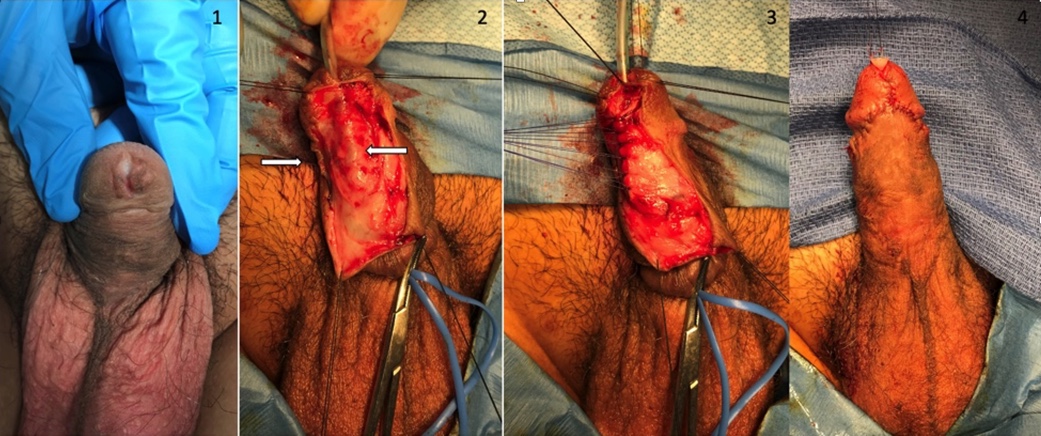Back
Poster, Podium & Video Sessions
Moderated Poster
MP08: Pediatric Urology: Penis & Scrotum
MP08-07: Long term consequences of failure to repair corpus spongiosum in distal hypospadias
Friday, May 13, 2022
10:30 AM – 11:45 AM
Location: Room 225
David Ali*, Paterson, NJ, Moneer Hanna, New York, NY

David S. Ali, MD,MPH
Urology Resident
Rutgers New Jersey Medical School
Poster Presenter(s)
Introduction: Several surgical techniques have been described in the repair of hypospadias; however, none mention the role of repairing the corpus spongiosum. Herein we review our experience with adolescents who underwent hypospadias repair during childhood and their main complaints were partially or totally related to spongiosum defects. Their surgical outcomes are also discussed.
Methods: Between 2007 and 2017, 26 patients aged between 13 and 28 years of age (median 19 years) were operated upon to repair of the deficiency or absence of corpus spongiosum. The primary hypospadias repairs included meatal advancement and glanduloplasty (MAGPI) repair (N=10); tubularized incised plate (TIP) (N=9), and in 7 patients the primary repair was unknown.
Results: The main complaints were urinary infections (N=5), spraying of the urinary stream and dripping of urine (N=10) and distal urethral swelling during voiding (N=15). In 5 patients, the urethral wall was thin and covered with adherent epidermis only. In 14 patients, the laterally displaced spongiosum pillars were mobilized and approximated using interrupted log lasting absorbable sutures. Four patients had significant spongiosum deficiency and urethral swelling during urination resulting in mild diverticulum formation. In 2 patients the spongiosum pillars were fixed and could not be mobilized to provide a tension-free closure, a thick Dartos scrotal flap was used to cover the plicated urethral wall. 12 out of 25 patients underwent glandular contouring and/or meatoplasty simultaneously to improve the penile esthetics.
The median follow-up period was 4 years. 6 patients were excluded from this series due to no follow-up. 18 out of 19 patients reported normal and steady urinary stream, absence of urethral swelling during voiding and no postvoid dripping. One patient developed glans dehiscence and is voiding through a coronal meatus; he declined further surgery. None developed urinary infection. The mild curvature was corrected successfully in all 4 patients.
Conclusions: Failure to recognize and/or repair the corpus spongiosum defect during childhood distal hypospadias repair may become symptomatic during adolescence however, the abnormality can be corrected successfully.
Source of Funding: No source of funding was provided for this study.

Methods: Between 2007 and 2017, 26 patients aged between 13 and 28 years of age (median 19 years) were operated upon to repair of the deficiency or absence of corpus spongiosum. The primary hypospadias repairs included meatal advancement and glanduloplasty (MAGPI) repair (N=10); tubularized incised plate (TIP) (N=9), and in 7 patients the primary repair was unknown.
Results: The main complaints were urinary infections (N=5), spraying of the urinary stream and dripping of urine (N=10) and distal urethral swelling during voiding (N=15). In 5 patients, the urethral wall was thin and covered with adherent epidermis only. In 14 patients, the laterally displaced spongiosum pillars were mobilized and approximated using interrupted log lasting absorbable sutures. Four patients had significant spongiosum deficiency and urethral swelling during urination resulting in mild diverticulum formation. In 2 patients the spongiosum pillars were fixed and could not be mobilized to provide a tension-free closure, a thick Dartos scrotal flap was used to cover the plicated urethral wall. 12 out of 25 patients underwent glandular contouring and/or meatoplasty simultaneously to improve the penile esthetics.
The median follow-up period was 4 years. 6 patients were excluded from this series due to no follow-up. 18 out of 19 patients reported normal and steady urinary stream, absence of urethral swelling during voiding and no postvoid dripping. One patient developed glans dehiscence and is voiding through a coronal meatus; he declined further surgery. None developed urinary infection. The mild curvature was corrected successfully in all 4 patients.
Conclusions: Failure to recognize and/or repair the corpus spongiosum defect during childhood distal hypospadias repair may become symptomatic during adolescence however, the abnormality can be corrected successfully.
Source of Funding: No source of funding was provided for this study.


.jpg)
.jpg)